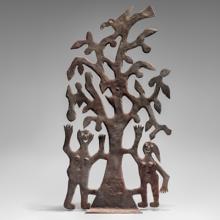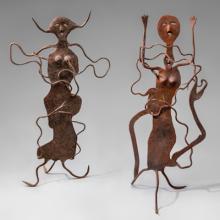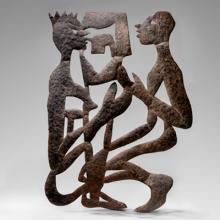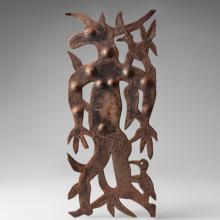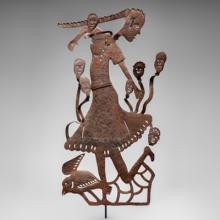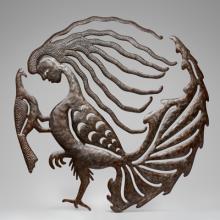International Terminal






Garden of Eden c. 1960s
Georges Liautaud (1899–1991)
Croix-des-Bouquets, Haiti
recycled steel oil drum
Collection of Larry Kent
L2023.1001.003
Georges Liautaud
“For Georges Liautaud there was little separation between art and life. Iron and the working of it were his spiritual spine.” —Randall Morris, Sacred Arts of Haitian Vodou (1995)
Georges Liautaud (1899–1991) worked as a blacksmith for several years repairing railways. During the 1940s, he opened a forge in his hometown of Croix-des-Bouquets where he fabricated mechanical parts, repaired items, and made crosses for cemeteries. An encounter with U.S. painter DeWitt Peters (1902–66) in 1953, who helped found Le Centre d’Art in Port-au-Prince, Haiti, inspired Liautaud to explore metalworking as an artform. Using recycled oil drums, scraps of iron and iron chains, barbed wire, and other metals, and employing a hammer, anvil, chisel, and welding iron, he crafted sculptures embodying many themes—from spirits of the Haitian Vodou pantheon to whimsical figures of his imagination. A visionary artist, Liautaud founded the Haitian metal sculpture movement. His sculptures are in the permanent collections of MoMA in New York, the Milwaukee Art Museum, and Le Centre d’Art in Haiti, among others.
Steel oil drum containers were initially left behind by U.S. Marines between 1915 and 1934 during the United States’ occupation of Haiti following the assassination of Haiti’s president Jean Vilbrun Guillaume Sam (1859–1915) in 1915. Haitians such as Liautaud soon began repurposing them. These same steel oil drums are also used to create steel pan drums in Trinidad & Tobago. Today, with so many Haitian artists working in the medium and selling and exporting works, artisans now purchase steel oil drums to craft metal sculpture, employ used or new fifty-gallon tomato paste drums, or even use sheet metal for large-scale commissions.

Georges Liautaud with his tools c. 1960s
Photograph by William Grigsby
Croix-des-Bouquets, Haiti
Collection of Larry Kent
©Randall Morris
L2023.1001.001.27
Entwined figures c. 1960s
Georges Liautaud (1899–1991)
Croix-des-Bouquets, Haiti
recycled steel oil drum
Collection of Larry Kent
L2023.1001.010, .011
Georges Liautaud
To create his sculptures, Georges Liautaud (1899–1991) first made a rough drawing on paper, or simply drew the shape of the figure freehand onto the metal. Liautaud then placed the piece on his anvil and, using a chisel and hammer or shears, cut the form from the metal sheet. He carefully filed and smoothed the edges of the pieces—though he might intentionally leave some areas rough. Liautaud employed a small hammer with a round tip to make subtle hollows in the metal to give his sculptures more dimension. He applied face details to many of his figural sculptures, often incising hair and adding eyelashes. Finally, Liautaud often bent different parts of the sculpture to add even more depth before cutting and attaching a support to enable the figure to stand.
Many of Liautaud’s sculptures represent Haitian Vodou spirits or lwa. which mirror different facets of nature and life. For instance, Danbala is an ancient Dahomean serpent spirit associated with water, healing, and wisdom, who is often entwined with his wife, the female serpent rainbow, Ayida Wèdo.

Georges Liautaud working on a sculpture c. 1960s
Photograph by William Grigsby
Croix-des-Bouquets, Haiti
Courtesy of the Cavin-Morris Gallery
©Randall Morris
R2023.1004.002
Entwined figures c. 1960s
Murat Brièrre (1938–88)
Croix-des-Bouquets, Haiti
recycled steel oil drum
Courtesy of Indigo Arts Galley
L2023.1003.002
Murat Brièrre
Brièrre “sculpts his life, reveals his obsessions, his weaknesses, his alienations, his daydreams, his joie de vivre, but also his sense of humor.” —Le Centre d’Art, Haiti
Murat Brièrre (1938–88) served in various trades, including as a blacksmith, prior to becoming an artist. He met renowned Haitian painter Rigaud Benoit (1911–86) who encouraged Brièrre to paint and introduced him to Le Centre d’Art in Port-au-Prince in 1956 where Brièrre studied drawing and painting. Brièrre decided to shift gears in the mid-1960s and instead focused on metalwork. He was the first to study under Georges Liautaud (1899–1991), and he quickly gained recognition as one of the preeminent metal sculptors of Haiti. Brièrre premiered new themes, such as sunbursts with facial expressions and pregnant women carrying babies in their bellies. Fantastical creatures and figures linked together to form narratives comprise some of his highly imaginative, distinctive work. Like other Haitian artists, much of his sculpture displays elements of Haitian Vodou. Brièrre’s metalwork has been exhibited in France and the United States among other countries and is held in the permanent collections of museums, such as Le Centre d’Art in Port-au-Prince, the Waterloo Center for the Arts in Waterloo, Iowa, and the Milwaukee Art Museum.
Horned figure with two birds c. 1970s
Sérésier Louisjuste (b?)
Croix-des-Bouquets, Haiti
recycled steel oil drum
Collection of Susan Tselos
L2023.1002.001
Louisjuste Brothers
The Louisjuste brothers—Sérésier, Janvier, and Joseph (1940–89) were born in Croix-des-Bouquets, Haiti. They learned to sculpt in metal from Georges Liautaud (1899–1991) and began garnering international attention for their work in the 1970s. The brothers developed a similar artistic style, often embellishing the surfaces of their sculptures with lively incised lines. Although the three worked as individual sculptors, they also collaborated on pieces. The brothers played an integral role in disseminating cut-metal sculpture to numerous other fledgling artists in Croix-des-Bouquets. Gabriel Bien-Aimé (b. 1951) and Serge Jolimeau (b. 1952)—the two most revered contemporary Haitian metal sculptors—both studied under the Louisjuste brothers. The Louisjuste brothers’ work is held in several permanent museum collections in the United States, including the Lowe Art Museum in Miami, Florida, and the Figge Art Museum in Davenport, Iowa.
Dancing figure 2021
Gabriel Bien-Aimé (b. 1951)
Croix-des-Bouquets, Haiti
recycled steel oil drum
Collection of Leonard Majzlin, courtesy of Indigo Arts Gallery
L2023.1003.004
Gabriel Bien-Aimé
Gabriel Bien-Aimé (b. 1951) grew up in Croix-des-Bouquets, the center of Haitian metal sculpture. Bien-Aimé worked as an auto mechanic for several years before apprenticing to sculptor Janvier Louisjuste. Bien-Aimé began gaining recognition for his work in the 1980s. He creates intricate cutwork with elaborate surface decoration in a whimsical fashion, rarely repeating the same imagery. His sculptures depict various animals and imaginative creatures, such as angels and horned figures, reflecting both Catholic and Vodou iconography, as well as themes inspired by the natural world. Bien-Aimé has relatives in the United States and lived in Boston from 1999 to 2015 when he returned to Haiti. Bien-Aime’s sculptures have been included in numerous international exhibitions. His works are in the permanent collections of the Musée du quai Branly in Paris as well as the Figge Art Museum in Davenport, Iowa, the Milwaukee Art Museum, Le Centre d’Art and the Musée d’Art Haïtien du Collège Saint-Pierre in Port-au-Prince.

Gabriel Bien-Aimé at the International Folk Art Market July 2023
Santa Fe, New Mexico
Photograph courtesy of Anthony Hart Fisher
R2023.1005.001
Bird woman c. 1995
Serge Jolimeau (b. 1952)
Croix-des-Bouquets, Haiti
recycled steel oil drum
Courtesy of Indigo Arts Gallery
L2023.1003.009
Serge Jolimeau
One of Haiti’s most celebrated metal sculptors, Serge Jolimeau (b. 1952) began an apprenticeship as an adolescent when very few sculptors worked in the medium of cut metal. After training with Sérésier Louisjuste, he joined Le Centre d’Art in 1972 where he met and was further mentored by Murat Brièrre (1938–88). Jolimeau often creates large-scale, two-dimensional sculptures in the form of bold, sensuous mermaids or sirens. Since childhood, he has observed and admired birds, which also appear frequently in his work. For decades, the artist has inspired and nurtured fledgling metal sculptors in the under-served town of Croix-des-Bouquets. Like Gabriel Bien-Aimé (b. 1951), Jolimeau fled Croix-des-Bouquets in the fall of 2022 as gangs overtook the artistic village of Noailles. He set up a workshop in the town of Mirebalais, approximately forty miles northeast of his hometown.
In 2009, Jolimeau created a commemorative work for the Clinton Global Citizen Awards. Jolimeau has participated in the International Folk Art Market in Santa Fe. His work has been exhibited in Europe, Mexico, and the United States, and is in the permanent collections of several museums in the United States, such as the Figge Art Museum in Davenport, Iowa, in addition to several museums in Haiti, including the Musée de Panthéon National Haïtien and Le Centre d’Art.

Serge Jolimeau 2018
Santa Fe, New Mexico
Photograph courtesy of International Folk Art Alliance
R2023.1006.001
